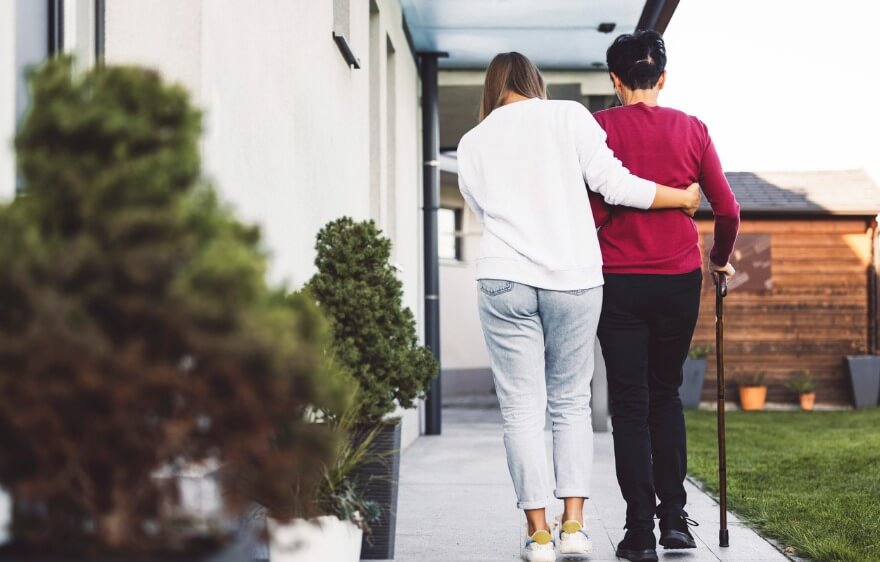Anyone who cares for a child knows it is a labor of love, filled with joy, challenges, and countless memorable moments. When your child is diagnosed with a rare condition like Ehlers-Danlos Syndrome (EDS), the journey can feel overwhelming and uncertain. As a parent or caregiver, it’s natural to want to know more about the condition and to have questions about what lies ahead.
We’re sharing this helpful blog to provide you with comprehensive information about Ehlers-Danlos Syndrome, including its causes, symptoms, diagnosis, and treatment. We’ll also share practical tips on caring for a child with Ehlers-Danlos Syndrome in a way that helps support a happy and fulfilling life.
What is Ehlers-Danlos Syndrome?
Ehlers-Danlos Syndrome (EDS) is a group of genetic disorders that primarily affect the connective tissues in the body. In particular, EDS usually alters the connective tissue that supports the skin, bones, blood vessels, and other organs and tissues. Because connective tissue provides strength and flexibility to various structures, it can lead to health problems. EDS causes excessive flexibility of the joints, skin that stretches more than usual, and patient’s experience tissue fragility. The condition varies in severity, ranging from relatively mild symptoms to significant challenges.
There are different types of EDS, each with its own unique set of symptoms and complications. The most common types include hypermobile EDS (hEDS), classical EDS (cEDS), and vascular EDS (vEDS). Understanding the type they have is crucial for caring for a child with Ehlers-Danlos Syndrome and implementing an effective treatment plan.
Ehlers-Danlos Syndrome Causes
Ehlers-Danlos Syndrome is a genetic condition, meaning it is passed down from parents to children through their genes. The majority of EDS cases are inherited in an autosomal dominant pattern, which means that only one copy of the altered gene is enough to cause the disorder. However, some types of EDS are inherited in an autosomal recessive pattern, requiring two copies of the altered gene—one from each parent — for the condition to manifest.
The specific genetic mutations responsible for EDS affect the production and structure of collagen, a protein that is a key component of connective tissue. Collagen provides strength and elasticity, so when it is defective, the connective tissues become weak, leading to the symptoms associated with EDS.
Ehlers-Danlos Syndrome Risk Factors
As a genetic disorder, the primary risk factor for Ehlers-Danlos Syndrome is a family history of the condition. If one or both parents carry the gene mutation associated with EDS, there is an increased risk of passing it on to their children. In families with a history of EDS, genetic counseling can be beneficial for anyone planning to have children, as it can provide information about the likelihood of inheriting the condition.
EDS affects both males and females across all ethnicities. While it is a rare condition, awareness and diagnosis are increasing, allowing more families to access the resources and support they need.
Ehlers-Danlos Syndrome Symptoms
The symptoms of Ehlers-Danlos Syndrome can vary depending on the type and severity of the condition. But there are still many common symptoms that parents and caregivers should be aware of when caring for a child with Ehlers-Danlos Syndrome:
- Joint Hypermobility: Children with EDS often have joints that move beyond the normal range of motion. This hypermobility can lead to joint pain, frequent dislocations, and sprains.
- Skin Elasticity and Fragility: The skin may be unusually stretchy and fragile, bruising easily and healing slowly. In some cases, scars may appear thin and widened.
- Chronic Pain: Many individuals with EDS experience chronic pain, particularly in the joints and muscles. This pain can be persistent and may require ongoing management.
- Gastrointestinal Issues: Children with EDS may have digestive problems, such as constipation, reflux, or irritable bowel syndrome (IBS).
- Fatigue: Chronic fatigue is a common symptom, often exacerbated by pain and sleep disturbances.
- Easy Bruising: Due to the fragility of blood vessels and connective tissues, children with EDS may bruise easily, even with minor injuries.
- Delayed Motor Development: Some children may experience delays in reaching motor milestones, such as walking or running, due to joint instability and muscle weakness.
- Cardiovascular Complications: In rare cases, particularly with the vascular type of EDS, there can be serious complications involving the blood vessels, such as arterial rupture.
Diagnosing Ehlers-Danlos Syndrome
Diagnosing Ehlers-Danlos Syndrome can be challenging due to the wide variability in symptoms and the rarity of the condition. It is still important for physicians to diagnose this condition as early as possible to manage symptoms and prevent complications.
The diagnostic process typically involves:
- Clinical Evaluation: A thorough physical examination by a healthcare professional, often including an assessment of joint hypermobility, skin texture, and scarring patterns.
- Family History: A review of family medical history to identify any patterns of symptoms or diagnosed cases of EDS.
- Genetic Testing: In some cases, genetic testing can confirm the diagnosis by identifying mutations in the genes associated with EDS. Not all types of EDS can be detected through genetic testing.
- Specialist Referrals: Children at a higher risk of developing EDS may be referred to specialists such as geneticists, rheumatologists, or dermatologists for further evaluation and management.
Ehlers-Danlos Syndrome Treatment
While there is no cure for Ehlers-Danlos Syndrome, treatment focuses on managing symptoms and preventing complications. The treatment plan will vary depending on the type and severity of the condition, as well as the individual needs of the child.
Some common approaches to managing EDS include:
- Physical Therapy: Physical therapy can help strengthen muscles, stabilize joints, and improve mobility. A physical therapist can also teach children how to protect their joints during daily activities.
- Pain Management: Chronic pain is a significant issue for many children with EDS. Pain management strategies may include medications, such as acetaminophen or nonsteroidal anti-inflammatory drugs (NSAIDs), as well as alternative therapies like acupuncture or massage.
- Bracing and Mobility Aids: Some children may benefit from wearing braces or using mobility aids to support unstable joints and reduce the risk of injury.
- Wound Care: Due to the fragile nature of the skin, special care may be needed to treat wounds and prevent infections. This may involve the use of non-adhesive bandages and special dressings.
- Cardiovascular Monitoring: For children with the vascular type of EDS, regular monitoring of cardiovascular health is essential to detect and manage potential complications.
- Dietary and Gastrointestinal Support: A dietitian may be involved in managing gastrointestinal symptoms, ensuring that the child receives adequate nutrition and addressing any digestive issues.
Tips for Caring for a Child with Ehlers-Danlos Syndrome
Caring for a child with Ehlers-Danlos Syndrome requires patience, understanding, and a proactive approach to managing their condition. Here are some practical tips to help you when caring for a child with Ehlers-Danlos syndrome:
- Educate Yourself and Others: Understanding EDS is the first step in caring for your child. Learn as much as you can about the condition, and educate family members, teachers, and caregivers so they can provide appropriate support.
- Create a Safe Environment: Make your home as safe as possible to prevent injuries. This may involve child proofing sharp edges, using non-slip mats, and encouraging your child to play on soft surfaces.
- Encourage Gentle Physical Activity: While it’s important to keep your child active, focus on low-impact activities that won’t strain their joints. Swimming, yoga, and cycling are great options.
- Develop a Pain Management Plan: Work with your child’s healthcare team to develop a comprehensive pain management plan. This may include a combination of medication, physical therapy, and relaxation techniques.
- Prioritize Skin Care: Teach your child gentle skin care practices to avoid cuts and bruises. Use mild soaps, moisturize regularly, and opt for clothing made of soft fabrics.
- Monitor for Signs of Complications: Be vigilant about monitoring your child for any new or worsening symptoms. Early detection of complications can make a significant difference in treatment outcomes.
- Communicate Openly With Healthcare Providers: Keep an open line of communication with your child’s healthcare team. Regular check-ups and honest discussions about your child’s symptoms and challenges are essential for effective care.
- Support Emotional Well-being: Living with a chronic condition can be emotionally challenging for children. Encourage open conversations about their feelings and consider seeking support from a therapist or counselor if needed.
- Connect with Support Groups: Joining a support group for families affected by EDS can provide valuable emotional support, resources, and advice from others who understand what you’re going through.
- Advocate for Your Child: Be your child’s strongest advocate in all aspects of their life, whether it’s at school, during medical appointments, or in social settings. When caring for a child with Ehlers-Danlos Syndrome, parents and primary caregivers are the people best positioned to ensure children receive the accommodations and support they need to thrive.
Find the EDS Care Your Child Deserves
Caring for a child with Ehlers-Danlos Syndrome comes with its unique set of challenges, but it is also an opportunity to nurture resilience, adaptability, and strength in both your child and yourself. With the right knowledge, support, and care, children with EDS can lead fulfilling lives, full of love, laughter, and growth. Remember, you are not alone on this journey — there are resources, healthcare providers, and communities ready to support you every step of the way.
Pediatric home health nursing can be invaluable for families caring for a child with Ehlers-Danlos Syndrome (EDS). At Care Options for Kids, our team of highly trained nurses provides personalized care in the comfort of home, offering medical support tailored to each family’s unique needs. We’re committed to ensuring everyone we help receives consistent, expert care, while also providing emotional support and guidance to help navigate the complexities of living with EDS.
Schedule Your Child’s Care Assessment Today
At Care Options for Kids, we understand the unique challenges of caring for a child with basic to medically fragile health conditions. Our dedicated team of pediatric home health care nurses is here to support your family with compassionate, expert care tailored to your child’s needs. Contact us today to schedule an assessment and learn how we can help you navigate this journey with confidence and care.
Click here to start your journey to better care.






